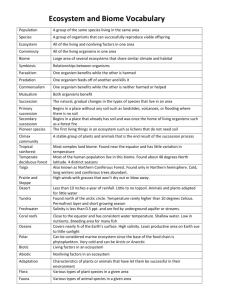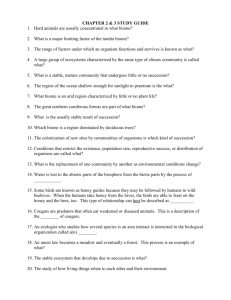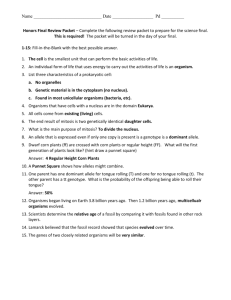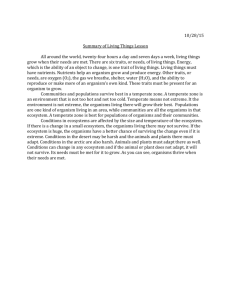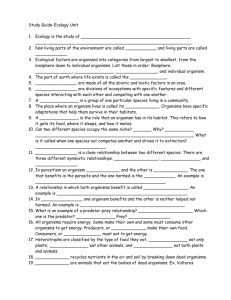Ecology Review Facts
advertisement
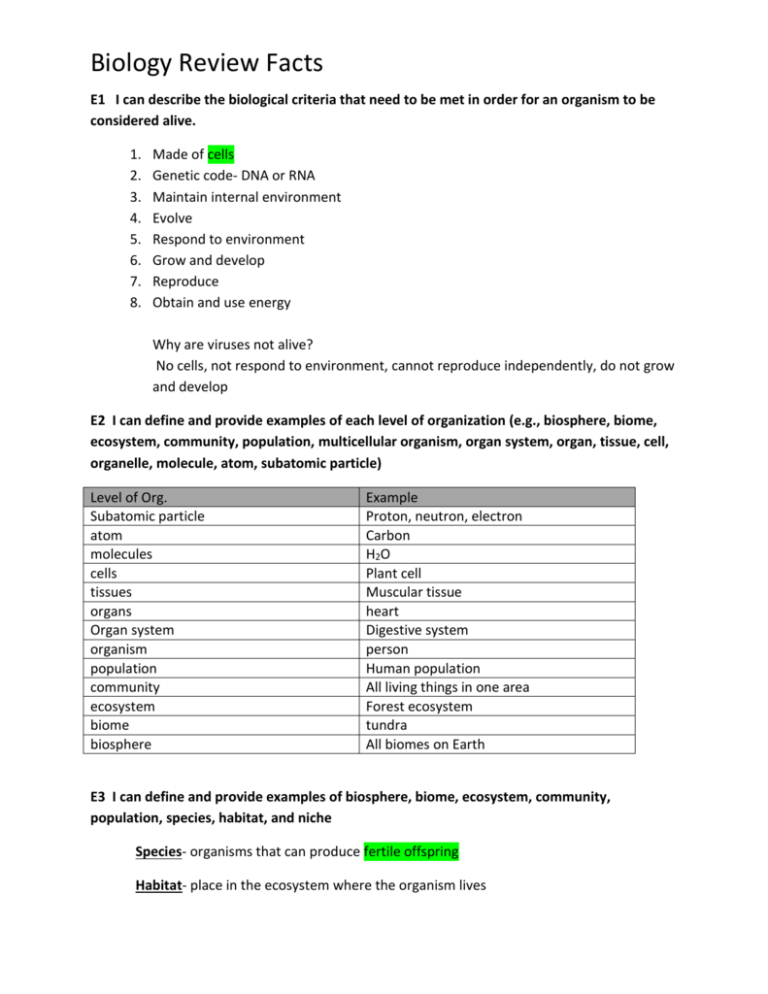
Biology Review Facts E1 I can describe the biological criteria that need to be met in order for an organism to be considered alive. 1. 2. 3. 4. 5. 6. 7. 8. Made of cells Genetic code- DNA or RNA Maintain internal environment Evolve Respond to environment Grow and develop Reproduce Obtain and use energy Why are viruses not alive? No cells, not respond to environment, cannot reproduce independently, do not grow and develop E2 I can define and provide examples of each level of organization (e.g., biosphere, biome, ecosystem, community, population, multicellular organism, organ system, organ, tissue, cell, organelle, molecule, atom, subatomic particle) Level of Org. Subatomic particle atom molecules cells tissues organs Organ system organism population community ecosystem biome biosphere Example Proton, neutron, electron Carbon H2O Plant cell Muscular tissue heart Digestive system person Human population All living things in one area Forest ecosystem tundra All biomes on Earth E3 I can define and provide examples of biosphere, biome, ecosystem, community, population, species, habitat, and niche Species- organisms that can produce fertile offspring Habitat- place in the ecosystem where the organism lives Biology Review Facts Niche - the role or the job that the organism performs in the ecosystem. (Organisms avoid competition by occupying different niches --- Competitive Exclusion Principle) E4 I can discuss biotic and abiotic factors that affect land and aquatic biomes Biotic- living (ex. of plants and animals for each) Abiotic – nonliving (rainfall, seasons, soil type) Review biome characteristics E5 I can discuss the role of beneficial bacteria (e.g., in the recycling of nutrients) Bacteria are essential in converting nitrogen into a form that can be used by plants and animals. Fixing bacteria are naturally found in the roots of legumes. Decomposers- help release nutrients so they do not stay trapped in dead organic material Help digestive system by breaking down materials that animals cannot break down on their own. E6 I can explain how energy flows through ecosystems in one direction, from photosynthetic organisms to herbivores to carnivores and decomposers Sun- Autotroph (producers)-heterotroph (consumers)- decomposers Biology Review Facts E7 I can explain how the amount of life any environment can support is limited by the available matter and energy and by the ability of ecosystems to recycle the residue of dead organic materials Limiting factors- resources that are necessary to survive. Density dependent- competition for food, water & space; parasitism; predation Density independent- natural disasters, human disturbances, weather conditions **** We only have a limited # of nutrients (matter ) on Earth. So nutrients like nitrogen, oxygen, carbon must be recycled.****** E9 I can diagram the flow of energy using food webs, food chains, and pyramids (e.g., pyramid of energy, pyramid of biomass, and pyramid of numbers) SEE E6 E10 I can describe examples of competition, symbiosis, and predation Competition- when organisms fight for the same resource. Only occurs when vital for survival. Symbiotic Relationships: when two species live in close relationship with one another. 1. Mutualism (+,+) ex- flower and insect 2. Commensalism (+, 0) ex- shark and remora 3. Parasitism (+,-) dog and tick E11 I can explain the concept of carrying capacity Carrying capacity- the maximum number of organisms an ecosystem can support. When carrying capacity is reached resources become limited. Biology Review Facts E12 I can describe the growth of populations, including exponential and logistic growth (e.g., design and conduct an experiment investigating bacterial growth using appropriate calculations) Exponential growth: 1. When population reproduces at a constant rate. 2. Ideal conditions- no predation, no disease, unlimited resources. 3. Graph- J curve Logistic growth: 1. When the population levels off as resources become limited. 2. Usually occurs in nature 3. Graph- S curve E13 I can explain the process of ecological succession, and describe the different communities that result Primary Succession: 1. 2. 3. 4. no soil organisms inhabit an area for the first time Pioneer species- usually lichens Ex. Volcanic rock hardening after eruption or glacier melts that expose new rock. Secondary Succession: 1. Occurs after a natural disaster or human disturbance 2. Soil does remain 3. Ex. Wild fires, abandoned agriculture fields Climax Community- the end result of succession when the ecosystem is fully developed
